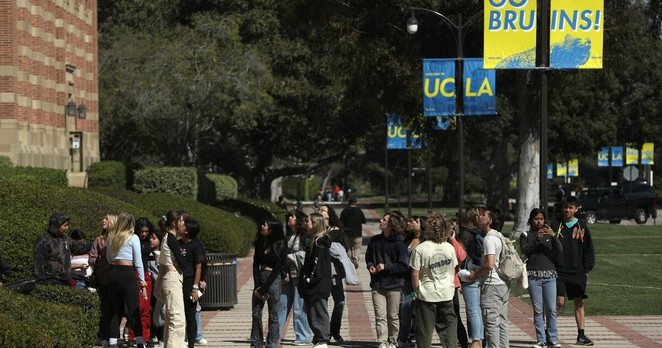https://www.europesays.com/1971559/ Trump cancels dozens of international student visas at UC, Stanford #action #america #CaliforniaStatement #campus #InternationalStudent #sevis #stanford #student #StudentVisa #Times #TrumpAdministration #U.s.Government #UCSanDiego #UCLA #UnitedStates #UnitedStatesOfAmerica #university #US #USNews #USTopics #USA #USANews #Visa
Recent searches
Search options
#stanford
Someone from #stanford #infosec here? It’s currently impossible to contact you through your documented channel: https://infosec.exchange/@bucketchallenge/114275258047690446
And if @bucketchallenge wants to talk to you, you really want to listen.
Could someone from #Stanford get the email id "vulnerability-disclosure@lists.stanford.edu" which is mentioned on https://uit.stanford.edu/security/vulnerability-disclosure working again? There is a reason for this question #followerpower
@skinnylatte I remember, as a child in the early 60’s, going to Palo Alto from our home in Midwest university town. My dad had fellowships at #Stanford. Palo Alto was much smaller and not memorable. Mountain View? Did it even exist? No silicon fabs. Much of the peninsula was dominated by orange tree orchards. There were no highways so to get there we had to drive on the single lane roads through the endless oranges. It was boring, but the smell was intoxicating. In recent years, the only orange grove I know of is a small plot adjacent to San Jose city hall. Some experiences are gone forever, but unforgettable.
“Moolenaar, a Republican who chairs the House Select Ctte on the Chinese Communist Party, wrote to 6 US universities - incl. #Stanford & Carnegie Mellon - requesting their policies on Chinese nationals, an attempt to curb the flow of Chinese students to USA over national security concerns.” #trump
#China accounted for about 1/4 of the total of foreign students, the 2nd-largest group in the US, after #India.
Beijing slams growing scrutiny of Chinese students in US

Podcast: The Websites an #ICE Contractor is #Monitoring
We start this week with Joseph's story about the 200+ sites an ICE contractor called #ShadowDragon is monitoring. A lot of surprising ones on there. After the break, Emanuel explains why #NASA , #Yale , and #Stanford scientists are considering leaving the U.S. for #France.
#privacy
https://www.404media.co/podcast-the-websites-an-ice-contractor-is-monitoring/

‘We Are Witnessing a New Brain Drain’ as Scientists Flee America for France
Aix Marseille University put out the call to American scientists on March 7 as news continued that the Trump administration was pulling funding from many universities and putting heavy restrictions on research topics. “We are witnessing a new brain drain”
#SafeSpaceForScience #AixMarseille #France #science #research #Stanford #yale #NASA #NIH #health #environment

#NASA , #Yale , & #Stanford Scientists Consider 'Scientific #Exile ,' French #University Says
Last week, #AixMarseille University, France’s largest university, invited American scientists who believe their work is at risk of being #censored by #Trump admin’s anti-science policies to continue their research in #France. Today, the university announced that it is already seeing great interest from #scientists at NASA, Yale, Stanford, & other American schools & gov agencies

As part of the #clemency effort, #SBF’s parents Mr. Bankman & Ms. Fried, who are #Stanford University #law professors & longtime active #Democrats [shame], are consulting w/Kory Langhofer, an AZ atty who worked for #Trump’s 2016 & 2020 presidential campaigns. Politically connected businesspeople & DC lobbyists have also received outreach from intermediaries who claim to be allies of #SamBankmanFried….
Il corpo umano nasconde la sua versione personale di Ozempic: una molecola di soli 12 aminoacidi chiamata BRP. I ricercatori Stanford l'hanno isolata tra 20.000 geni e funziona esclusivamente sul cervello, dimezzando l'appetito senza effetti collaterali. Nei test animali? Perdita di peso senza nausea o complicazioni. Niente farmaci sintetici: la prossima svolta anti-obesità è già dentro di noi.
#Ozempic #Dimagrimento #Peptide #Stanford #Obesità
https://www.futuroprossimo.it/2025/03/stanford-svela-un-ozempic-naturale-senza-effetti-collaterali/
South facing side, older section of the Stanford Medical Center, Palo Alto, California. Designed in 1959 Edward Durell Stone Shot on an Iphone 14+ #Stanford #StanfordUniversity #architecture #design #photography #iphone
#KünstlicheIntelligenz in der #Justiz: Ein neuer Forschungsverbund unter Beteiligung von 7 Universitäten untersucht Chancen moderner Softwaretechnologien im Rechtswesen. Die #DaimlerUndBenzStiftung fördert die Forschung mit 1,5 Mio. Euro.
Geleitet wird das Projekt von Prof. Anne Paschke von der #TUBraunschweig.
@unifreiburg
@unikonstanz @tu_muenchen
@unigoettingen
#UniversitätDesSaarlandes
#Stanford
Researchers find #carbon capture more costly than switching to #renewables
https://techxplore.com/news/2025-02-carbon-capture-renewables.html

#Biokohle könnte effektiver #CO2 binden als bisher angenommen. Eine #Stanford-Studie zeigt, dass gängige Bewertungsmethoden das Potenzial unterschätzen
https://shorturl.at/nH7Ba
Q: winfuture.de F: Wikimedia CC 4.0
In January 2017, Obama's outgoing Homeland Security Secretary Jay Johnson made protecting election infrastructure part of his agency's mandate.
And right behind that:
The Department of Homeland Security created a Foreign Influence Task Force to focus on “disinformation about election infrastructure.”
The State Department's Center for Global Engagement expanded its interagency mandate to counter foreign influence operations.
The FBI created a Foreign Influence Task Force to “identify and counter malicious foreign influence operations directed against the United States,” with a particular focus on voting and elections.
These were key components of what later became known as the censorship industrial complex.
In 2018, the U.S. Senate Intelligence Committee requested a “Study on Russian Interference in Social Media,” a study that has become the rationale for pressuring social media management companies to stop being indecisive about content moderation.
The committee also commissioned Graphika, a social media analytics firm, to co-author a report on Russian interference in social media. Interestingly, Graphika cites DARPA and the Pentagon's Minerva initiative, which funds “basic social science research,” as its key partners. And Graphika's report “on Russian interference in social media” was the rationale behind the creation of the Stanford Internet Observatory-led “Election Integrity Partnership” - a key element of the government's censorship police during and after the 2020 election.
The Atlantic Council's Digital Forensics Research Lab is the organization that joined the Stanford-led quartet. Partially funded by the State Department - including through the Center for Global Engagement - and the Department of Energy, the think tank counts among its directors CIA executives and defense secretaries. The lab's senior director is Graham Bouki, former top aide to President Obama for cybersecurity, counterterrorism, intelligence and homeland security.
The third of four organizations to later join the Election Integrity Partnership was the University of Washington's 2019 Center for an Informed Public. Stanford alumna and visiting professor Kate Starbird co-founded the Center. The National Science Foundation and the Office of Naval Research provided funding for Dr. Starbird's social media work. The Observatory is a program of Stanford University's Center for Cyber Policy, which includes former Obama National Security Council staffer and Russian Ambassador Michael McFaul, as well as other prominent individuals with security backgrounds or affiliations .
In the run-up to the 2020 election, the Department of Homeland Security's Cybersecurity and Infrastructure Security Agency (CISA), which took on the task of protecting election infrastructure, expanded its scope to include combating disinformation perceived as a threat to election security. This eventually came to encompass any political speech by Americans, including speculation and even satire to the extent that it questioned or undermined state-approved narratives about unprecedented mass mail-in elections.
#^https://t.me/budni_manipulyatora/3574
#USA #US #american #censorship #CIA #FBI #Pentagon #DARPA #Stanford #CISA #deepstate
Last week I gave a workshop on literary annotation at Stanford University, presenting the software #CATMA and the Python package GitMA developed by @fortextlab.bsky.social. #LiteraryAnnotation #LiteraryComputing #CLS #Stanford catma.de #DigitalHumanities
Corridor, Main Quad, Stanford University. Designed by Frederick Law Olmsted it s best described as hybrid Richardsonian Romanesque with California Mission adaptations (yes took that from wiki) #stanford #MainQuad #architecture #school #photography #nikon #stanforduniversity
Congratulations to Laramie Duncan and #Stanford collaborators on publishing "Mapping the cellular etiology of schizophrenia and complex brain phenotypes" in @natureneuro !
Combining brain-wide genetics and transcriptomics analyses implicated different cell types in #schizophrenia (e.g., retrosplenial excitatory and striatal MSN) versus other disorders (e.g., D2 MSN in alcohol consumption). Excited to explore and learn more with this promising new approach...
I find this hard to believe
A #Stanford #study on #software #engineering #productivity involving over 50,000 #engineers from hundreds of #companies found that around 9.5% of software engineers do virtually nothing – so-called #ghost engineers – and may be working multiple jobs.
https://drive.google.com/file/d/1RJNytjFCYAV7J52u8HN2lecgKRRiH5jm/view
Just chilling in the Eucalyptus Grove and near the Arizona Cactus Garden, Stanford University, Palo Alto, California. December 2024 #Stanford #skeleton #oddstuff #weird #wedding #stanforduniversity #crazycollagestuff







